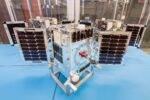California-based Impulse Space has announced a new mission architecture designed to deliver significantly larger payloads to the lunar surface. The system leverages a modular cislunar transport stack and partnerships with key players like Redwire to address emerging demand for high-mass cargo delivery under programs such as NASA’s Artemis and Commercial Lunar Payload Services (CLPS).
Modular Cislunar Architecture Targets High-Mass Lunar Logistics
Impulse Space’s proposed architecture centers around a scalable orbital transfer vehicle (OTV) stack that can be launched aboard heavy-lift rockets such as SpaceX’s Falcon 9 or Falcon Heavy. The OTV stack is designed to operate in multiple configurations depending on mission requirements—ranging from low Earth orbit (LEO) deployment to translunar injection (TLI) and lunar orbit insertion.
At the heart of the system is Impulse’s Helios propulsion platform—a high-performance chemical propulsion stage optimized for long-duration missions beyond Earth orbit. The Helios stage would act as the primary maneuvering element, capable of ferrying payloads from LEO to lunar orbit or directly into descent trajectories toward the Moon.
The architecture is explicitly designed for modularity and reusability. It allows integration of various payload adapters or lander systems depending on customer needs. This flexibility positions Impulse to serve both government-sponsored missions under CLPS and commercial customers seeking tailored access to cislunar space.
Redwire Partnership Adds Proven Lunar Lander Capability
A key component of the proposed system is its integration with Redwire’s proven lander platforms. According to the announcement, Impulse will utilize Redwire’s existing lunar lander designs—which have heritage from previous NASA-contracted CLPS efforts—to complete the final descent phase from lunar orbit to surface.
Redwire brings flight-proven avionics, guidance systems, and structural elements that reduce development risk and accelerate time-to-launch. By combining Impulse’s OTV with Redwire’s landers, the system offers end-to-end delivery capability from Earth launch through soft landing on the Moon.
This partnership also aligns with NASA’s emphasis on public-private collaboration in developing sustainable lunar infrastructure. With Artemis aiming for long-term presence on and around the Moon—including Gateway operations—the need for reliable cargo delivery systems is growing rapidly.
Payload Capacity Designed Around Emerging Lunar Demand
While specific mass figures were not disclosed in the initial announcement, industry analysts estimate that Impulse’s OTV stack could support payloads in excess of 500–1000 kg delivered directly onto the lunar surface—depending on launch vehicle selection and mission profile.
This places it in a higher-capacity tier compared to many current CLPS offerings that typically focus on small science instruments or CubeSats. The ability to deliver heavier infrastructure components—such as power systems, mobility platforms, or ISRU demonstrators—would fill a critical gap in upcoming Artemis support missions.
- Potential applications: Power distribution nodes, scientific drilling rigs, autonomous rovers
- Target customers: NASA CLPS contractors, international space agencies (e.g., ESA), commercial resource extraction ventures
- Lunar destinations: South Pole-Aitken Basin sites prioritized by Artemis III–V planning
Cislunar Transport Stack Offers Reusability Pathways
The Helios platform is being developed with partial reusability in mind—particularly for stages operating between LEO and cislunar space. While full recovery from deep space remains technically challenging due to delta-v constraints and thermal loads during reentry, Impulse aims for staged reuse through orbital refueling or modular refurbishment in future iterations.
The company has previously demonstrated smaller-scale propulsion modules under its Mira program—a low-thrust electric propulsion system used for precise satellite positioning. Lessons learned from Mira are informing Helios development at scale.
If successful, this approach could reduce cost-per-kg over time while enabling more frequent cadence of lunar resupply missions—a key enabler for sustained human presence beyond Earth orbit.
Lunar Logistics Market Heating Up Amid Artemis Momentum
The unveiling comes amid intensifying competition in cislunar logistics. Several U.S.-based firms—including Astrobotic Technology (Peregrine/XEUS), Intuitive Machines (Nova-C), Firefly Aerospace (Blue Ghost), and Draper—have secured CLPS task orders from NASA totaling over $1 billion since 2019.
However, most current offerings are optimized for sub-300 kg payload classes. Impulse seeks differentiation by targeting higher-mass deliveries while leveraging modularity and rapid integration timelines enabled by its OTV design philosophy.
The company has not yet announced firm contracts but stated it is actively engaging with prospective customers across government and commercial sectors. A demonstration mission is tentatively slated within 24–36 months pending funding milestones and regulatory approvals.
Conclusion: A Scalable Approach Toward Sustained Lunar Access
If realized as described, Impulse Space’s architecture could offer an important logistical bridge between Earth-based launch assets and sustained infrastructure deployment on the Moon’s surface. By focusing on modularity, propulsion efficiency via Helios stages, and leveraging established partners like Redwire for landing capability—it presents a compelling alternative in an increasingly crowded field of lunar logistics providers.
The next key milestone will be hardware validation through ground testing followed by an orbital demonstration flight—in what may become one of several competing architectures shaping humanity’s return to deep space operations over this decade.










